Thule EnRoute Backpack 14L Review
The Thule EnRoute 14L is a great everyday bag, switching gears seamlessly from office to adventure, though the ease of use depends on the order we pack it.
Our Verdict
Save time. Get access to brief summaries of our reviews so you can browse and make decisions more efficiently.
Pros
- Lash points great for attaching small gear
- Shoulder and back padding comfy for extended use
- Strap keepers stay put
Cons
- Hard to use bag bottom with short main zipper
- Pockets compete for capacity
- Bag falls forward when unzipped
Technical Details
-
Capacity
14l
-
Weight (lb)
1.61 lb (0.7 kg)
-
Denier
330D
Nylon mini ripstop
-
Denier
600D
Polyester
-
Dimensions
17.3 in x 10.6 in x 7.9 in (43.9 x 26.9 x 20.1 cm)
-
Notable Materials
Ripstop Nylon, Polyester, Duraflex Hardware, YKK Zippers
-
Manufacturing Country
Vietnam
-
Laptop Compartment Size
13"
10" tablet pocket
-
Warranty Information
Full Review
The Thule EnRoute 14L Backpack offers great everyday features in a bag that easily transitions to action-packed travel. The creature comforts of breathable padded shoulder straps and a ventilated back panel make this a bag we look forward to carrying for hours on end. It has the pockets and organizational features we need for the office or digital nomad life and the space to bring drinks and snacks for exploring a new locale.
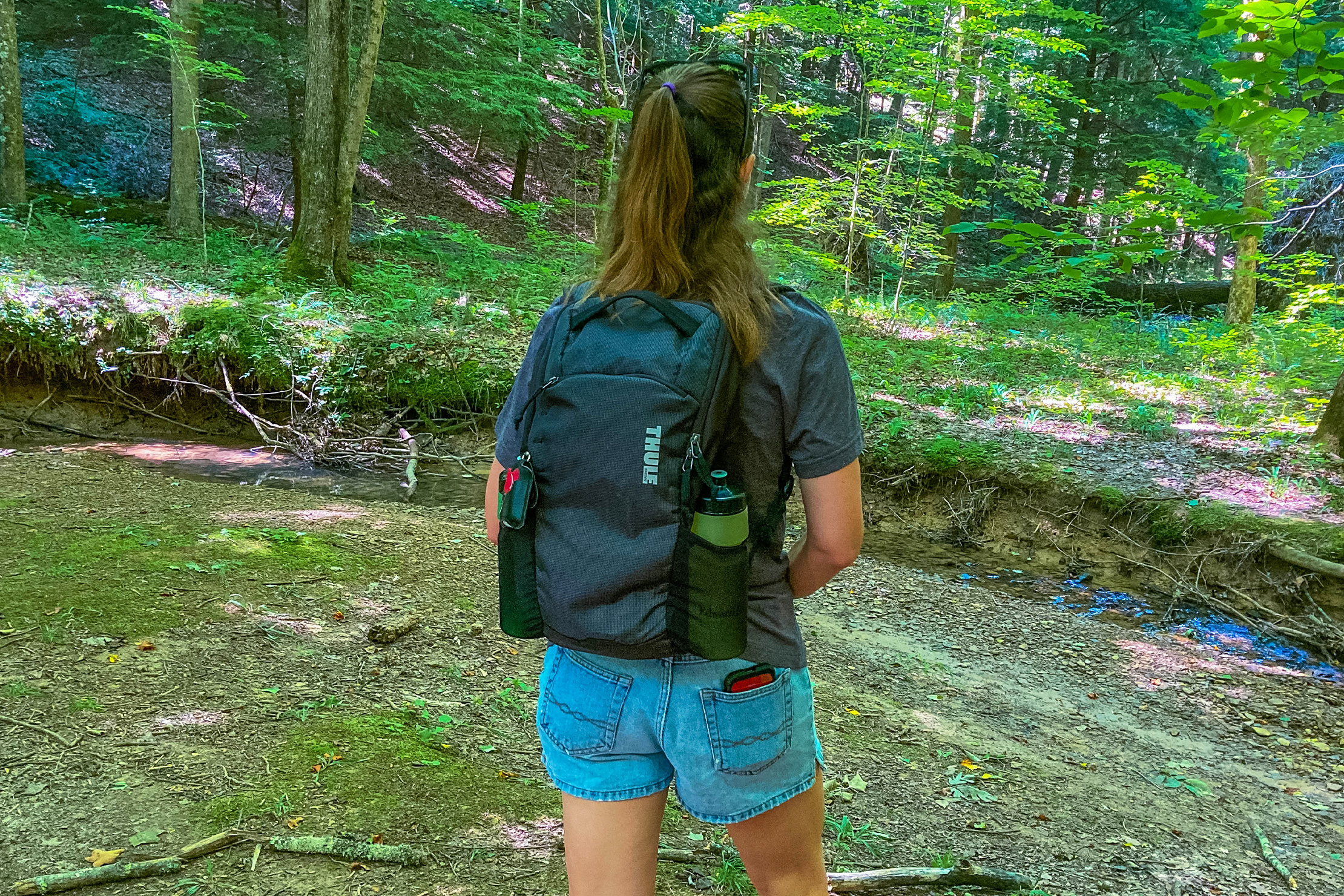
There are a few nuances needed for using this bag to its full potential, and we’ll cover them below. Let’s dive in.
Materials & Aesthetic
The Thule EnRoute 14L Backpack has clean lines and a style we appreciate. Each colorway offered at the time of review—Black, Asphalt, Rapids (bright blue), and Rooibos (red)—features 330D mini-ripstop nylon parading down the front of the bag and on the outward-facing portions of the shoulder straps. On the Black, a mini-dot pattern contrasts nicely with the primary color around the remainder of the pack, which is sturdier 600D polyester for more durability. The fabric wipes clean easily, even of sunscreen.

The ripstop nylon lines the interior of the bag in the same colorway as the exterior for the Black and Asphalt colorways, and in a contrasting light gray with the Rapids. We can’t confirm what the Rooibos looks like inside, but we feel confident we’ll like the look since we appreciate the style on the remaining colorways. The front pocket has a soft liner to protect your small tech. It’s a convenient spot for a phone, so this is a nice consideration to prevent scratches.
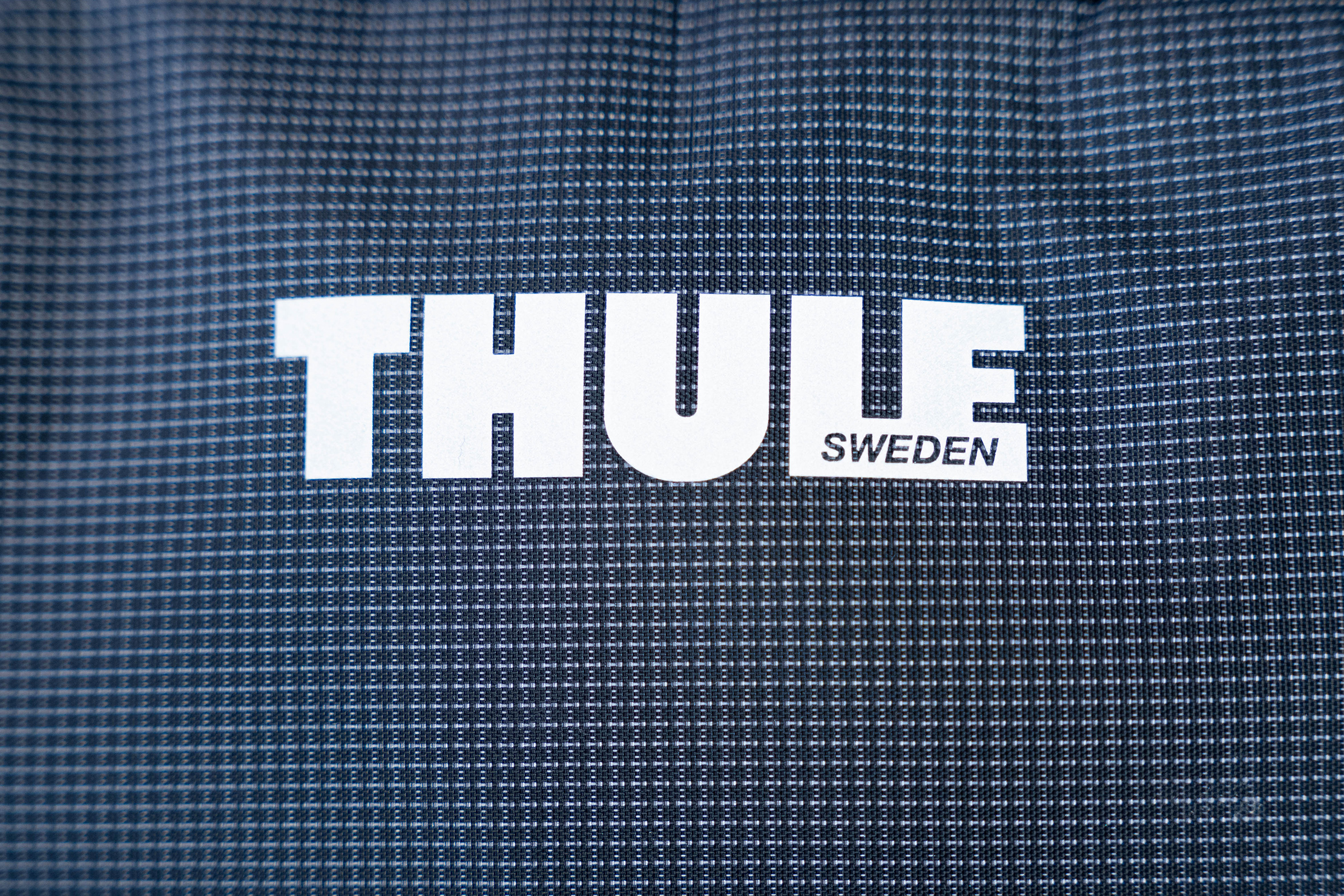
A 3-inch Thule Sweden logo runs vertically down the right side of the front of the bag. The silver print is reflective to keep you safe at night, and it also pops off the bag pleasantly. Another piece of branding is the Thule name on an attachment point on the left shoulder strap, but that’s it for logos.
Plastic Duraflex slides are on the shoulder straps, and YKK makes the exterior zippers. Two internal zippers appear to be unbranded. The exterior zippers all have thin webbing zipper pulls, making them easy to grasp, while the interior zippers lack pulls. Nevertheless, they work well.
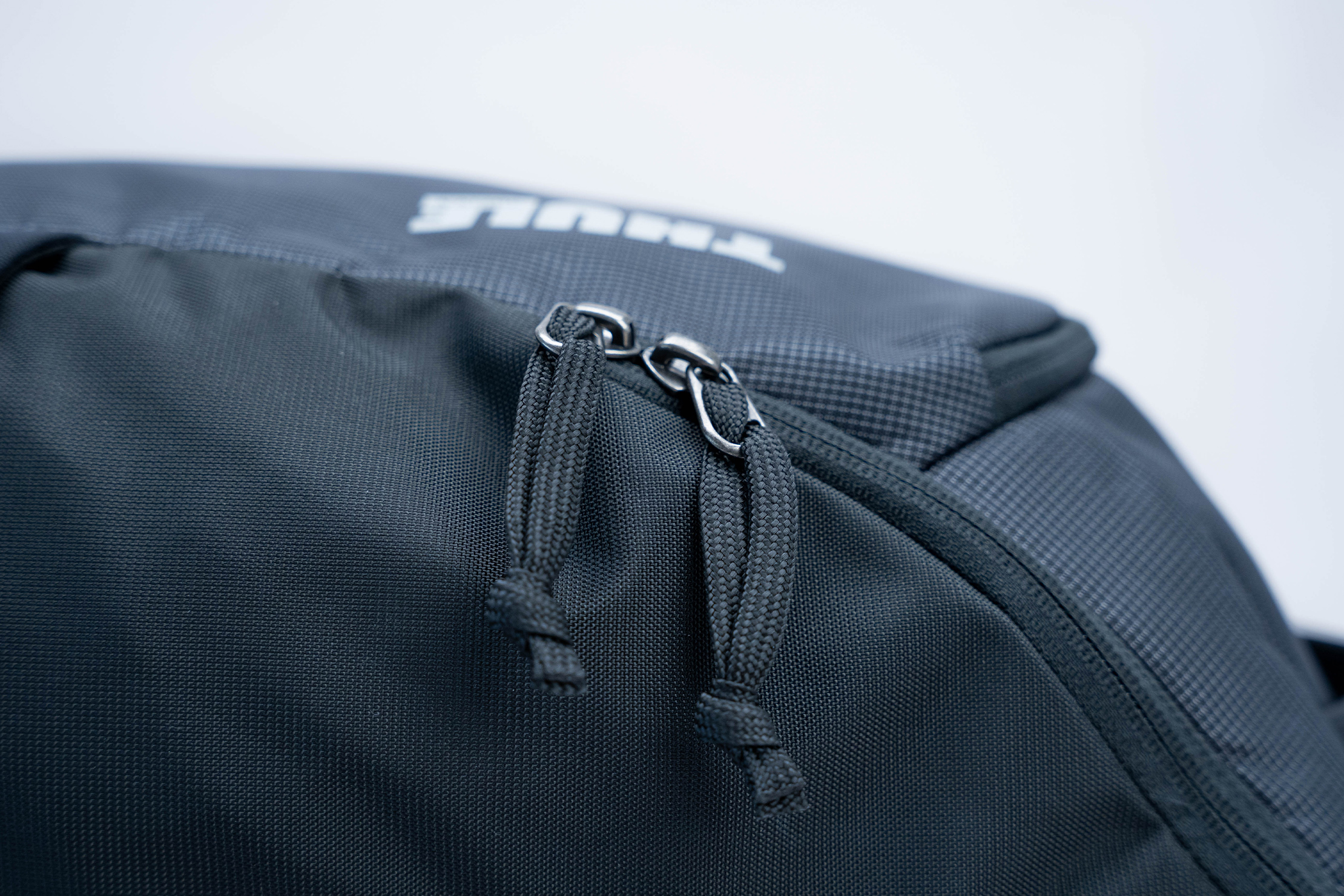
The only zipper giving us pause at the beginning of testing was the U-shaped main zipper. It needed a bit of breaking in and, while it slides better now, it was slowing about two inches before the end on either side to begin with. We’re not sure if that’s a function of the zipper or, more likely, the shape of the bag’s opening. We’ll cover that more later. Now, let’s look around at the rest of the exterior features.
External Components

Even though Thule markets the EnRoute 14L Backpack as an everyday use daypack, it has features we appreciate through hours of strenuous hiking, as well. It’s nice to find a pack that transitions from workday to weekend to travel, and Thule has done that here.

Starting at the top, a thin, doubled piece of webbing strap acts as a carry handle. It’s okay to pull the bag out of the car or hang it on a hook, but not much to write home about and not something we’d recommend for long-term use. The Thule EnRoute 14L is a backpack, after all, and the shoulder straps are the stars.
Taking a look at those, the EnRoute’s shoulder straps are pleasantly padded with breathable mesh on the undersides. That reduces sweating, even when hiking in 90℉ heat (32.2℃). The padding isn’t overly stiff, and their flexibility keeps them comfortable over hours of continued use.
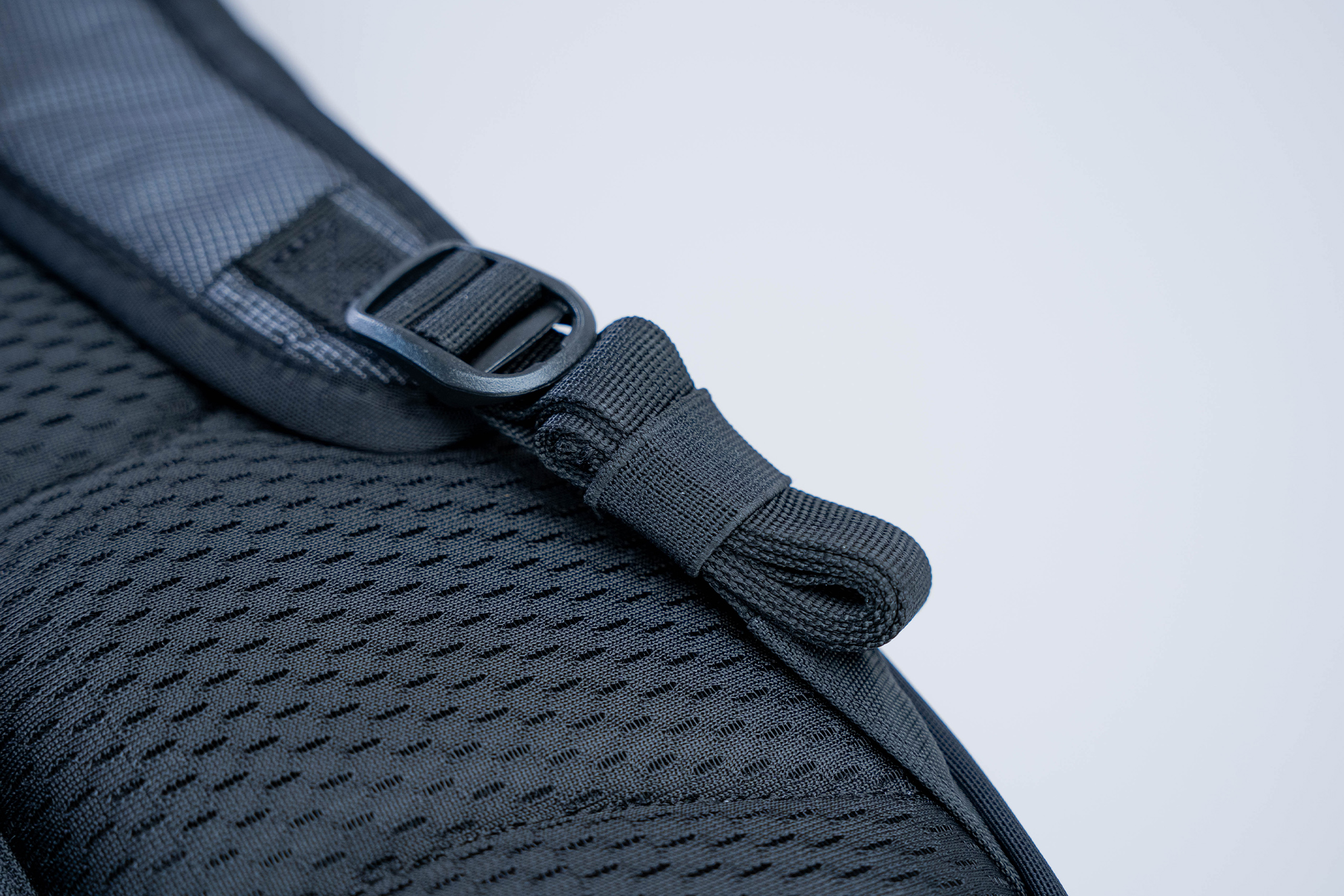
As we mentioned above, the straps are adjustable with Duraflex slides and (bonus!) have a small piece of elastic looping around the bottom for a strap keeper. We appreciate brands that go the extra mile to add features like this. It makes the straps a “set it and forget it” part of the bag, as they don’t move once you adjust them. The only issue we encounter here is, when taking a break from carrying the pack, tailoring the straps for a differently-sized user is slower as you must unroll and then reroll the excess straps to shorten or lengthen them. That’s a problem we’ll take to prevent the extra straps from lashing your legs and getting caught in rocks (while hiking) or doors (when dashing to the office).
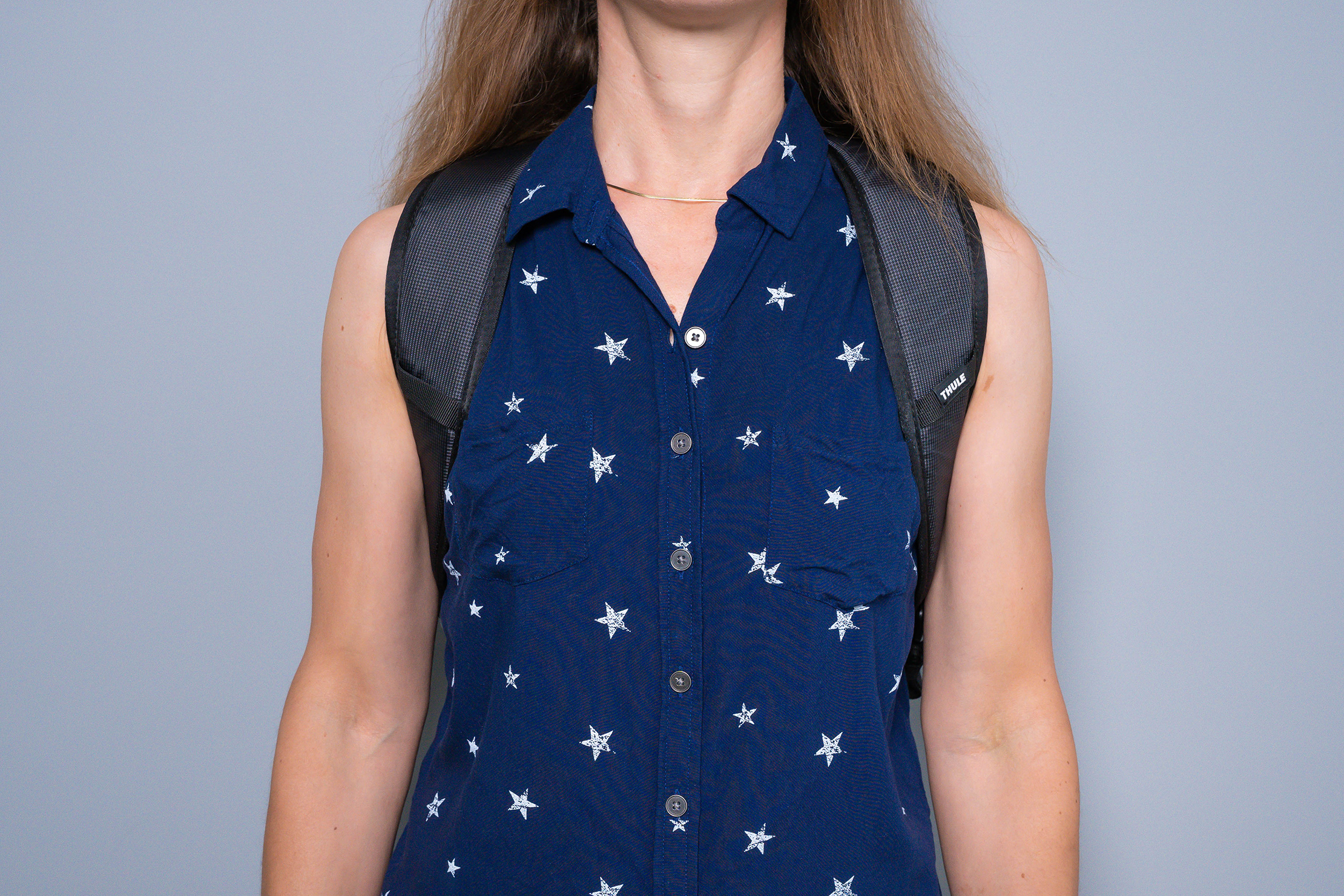
There aren’t any sternum or waist straps on this bag. It only has a 14L capacity, though, so there’s only so much weight we can add, and we didn’t miss them even while testing this bag on technical hikes in Ohio’s Hocking Hills. Walking for miles while climbing up and over rocks, the backpack stayed secure, and we stayed comfy.
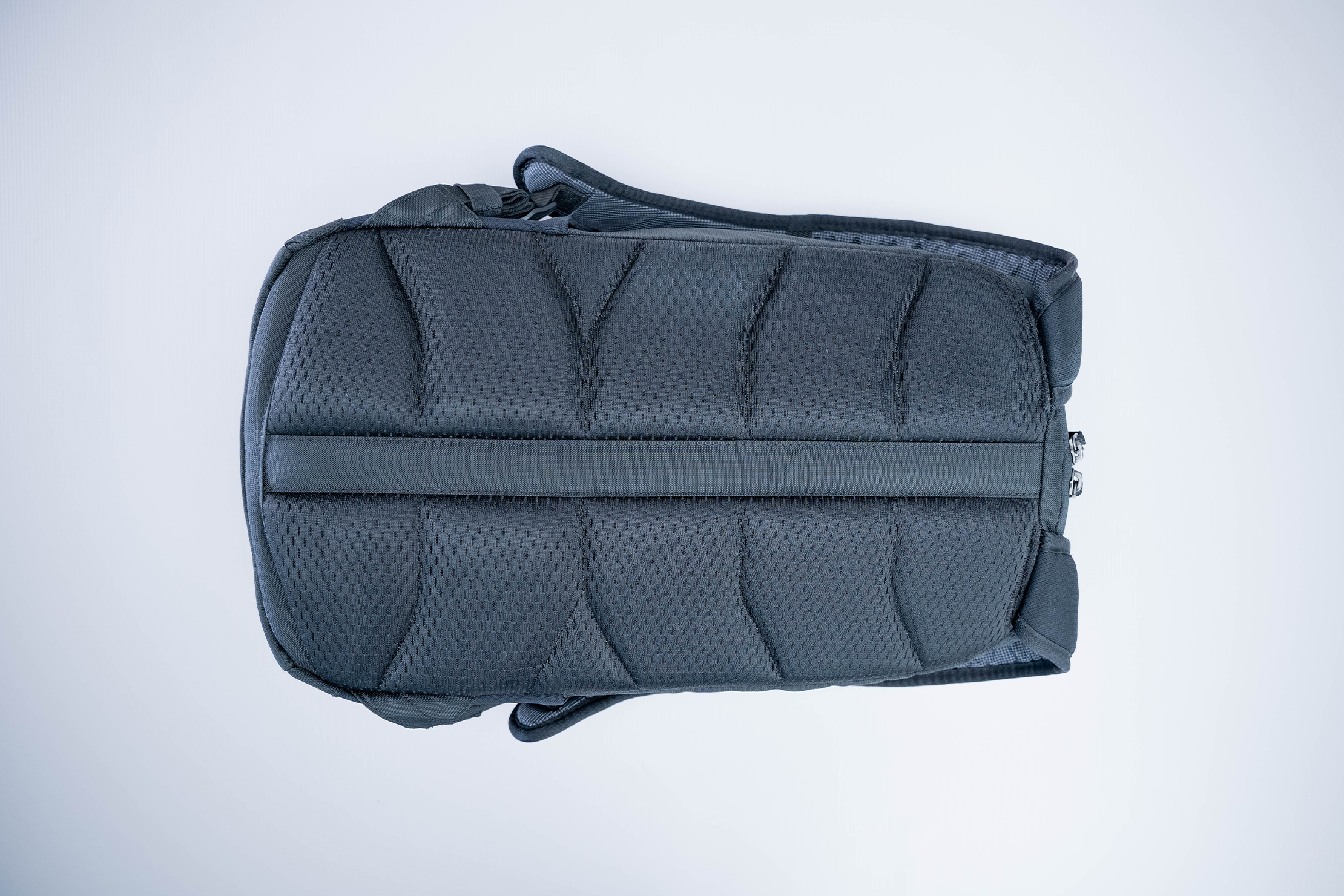
That probably has a lot to do with the well-padded, mesh-lined back panel. It has similar padding to the shoulder straps in that it protects backs from feeling anything in the bag while being flexible enough to conform to a back instead of digging in. It also features an airflow channel (a break in the padding) in the middle. While we still experience a sweaty back after carrying this pack for hours in the summer heat, it’s not excessive, and the mesh padding helps alleviate it.
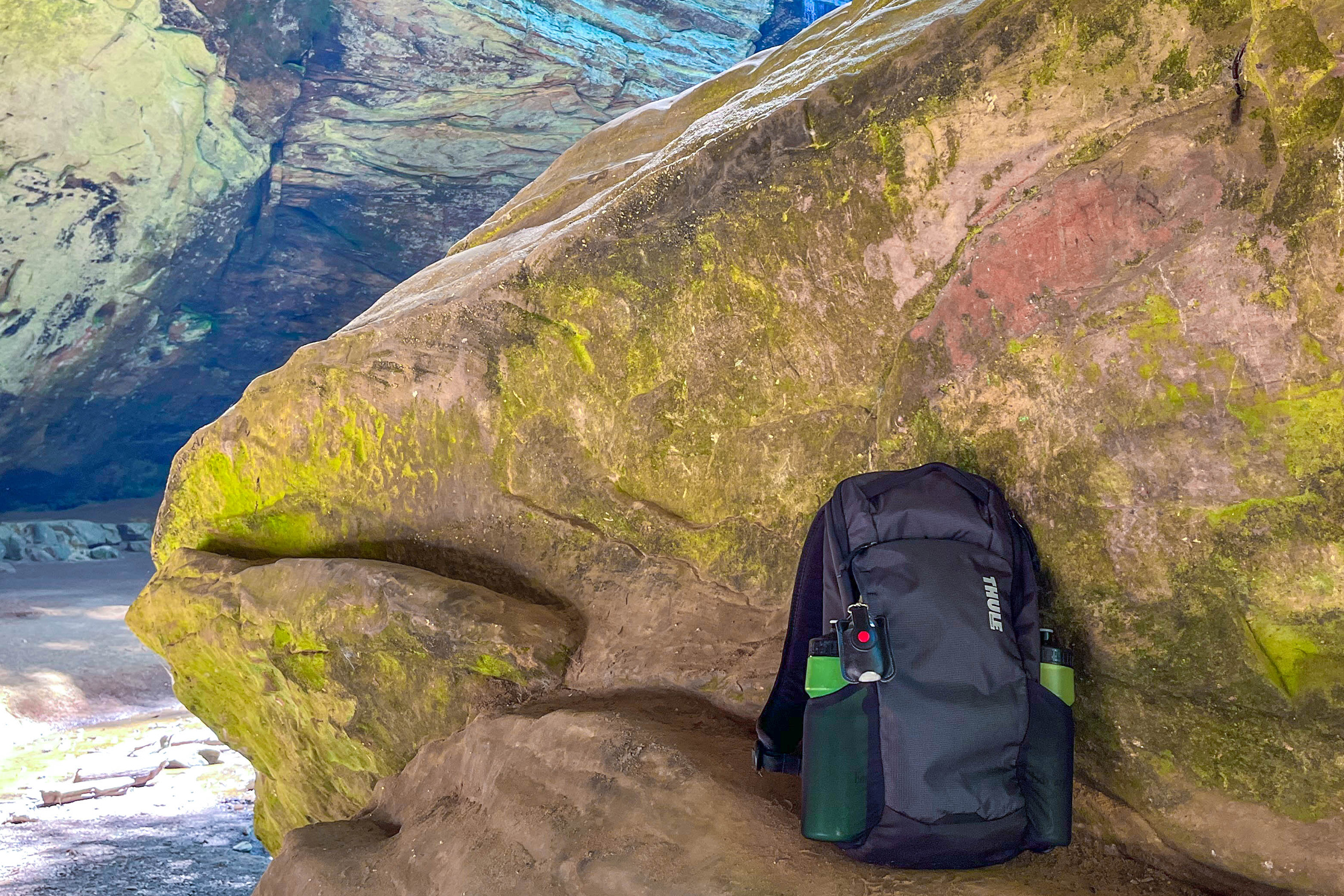
There are two stretchy, 6.5-inch wide nylon mesh pockets on either side of the bag. The top runs on an angle, making them 5-6 inches deep. The fabric’s stretch lets us fit a wide variety of bottles inside without slipping around or falling out. Added elastic at the top of the pockets keeps things extra secure. Although they look like tights, giving us pause as to their durability, we haven’t encountered any snags or tears. We’ll be sure to update the Usage Timeline in the future if they do.
With the pockets’ flexibility, we can easily remove and replace bottles in the pockets, even while wearing the backpack. Like many backpacks, the capacity of these side pockets can be impacted by how much we pack in the bag’s main compartment, so your mileage may vary when you use them.

There’s one more feature to mention before we head inside—external attachment points. About 6 inches from the top of the bag, there’s a fabric welt on the left-hand side. When we lift it, we find a daisy chain of four lash points on the front of the bag. We use a carabiner to attach hand sanitizer and a key fob and find it convenient to keep small gear accessible. A Matador Pocket Blanket would clip nicely here for pop-up picnics, and we also like keeping the Matador NanoDry Towel attached. You never know when you’ll need to dry off after playing in a waterfall or getting caught in the rain.
There are attachment points on each shoulder strap, as well, when we want to keep something very close at hand. Commuting by bike in the dark? At the center of the bag, near the bottom on the front, is one more place to clip a light so drivers can spot you in the dark. Safety first!
Inside The Pack
The Thule EnRoute 14L Backpack can hold quite a bit of gear, but the ease of use depends on the order we pack it.
The 7-inch wide and 6-inch deep front pocket is easy to access with a zipper and is lined with soft fabric to prevent scratches. It easily accommodates a phone, wallet, and other small essentials like lip balm and hand sanitizer. We can stuff quite a bit here, but the pocket mainly gets its depth by bulging into the inside of the backpack. That means that if you’ve packed a lot of gear in the internal mesh pockets—which we’ll discuss shortly—there’s less room to put things in this pocket.
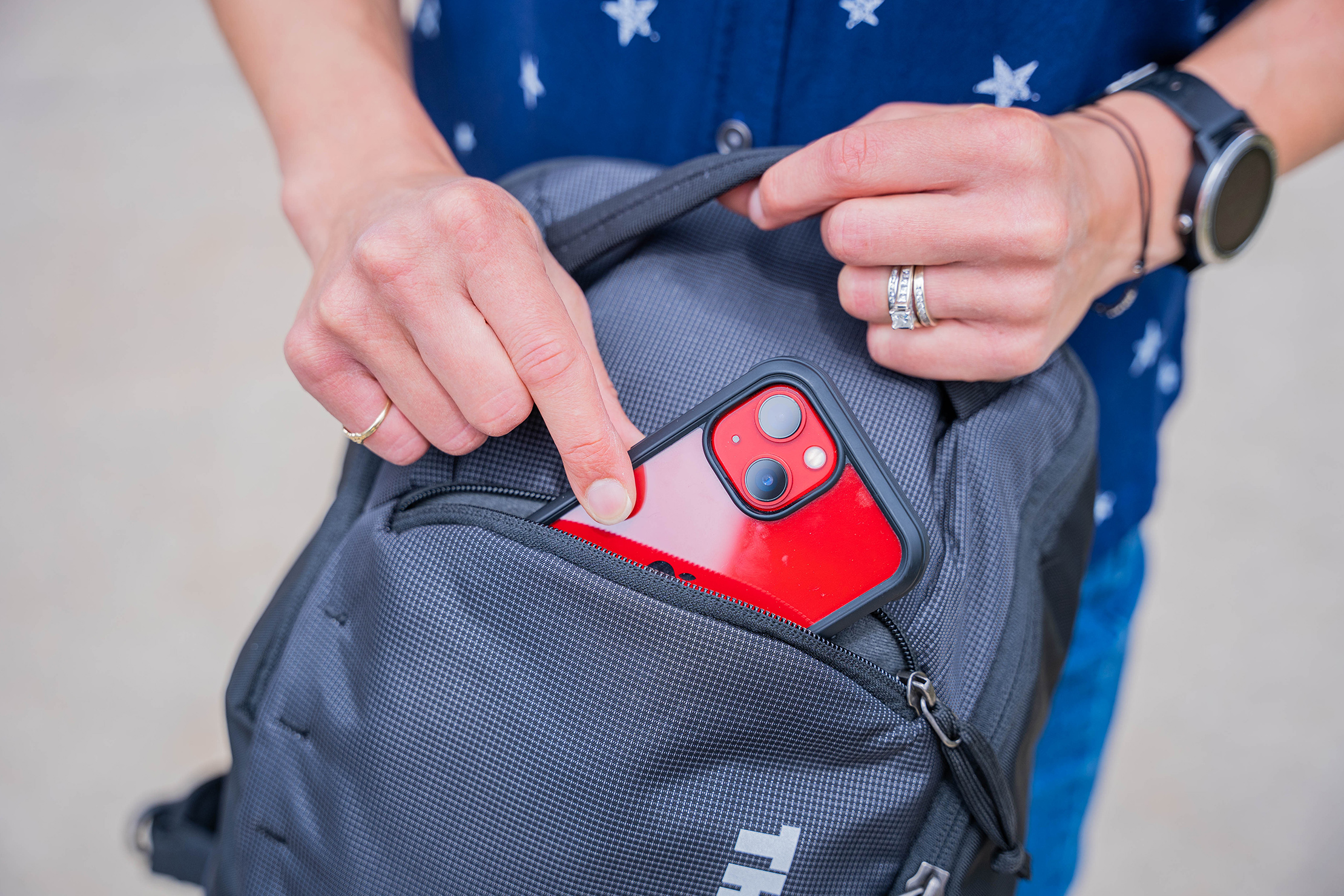
Order of operations comes into play here, too. We can fit so much into each pocket, but, for example, after pulling a phone out of the front pocket, it’s hard to shove it back inside because the contents of the internal pockets shift to fill the space vacated by the phone when we’re on the move. It happens less when parking the bag at a desk but is something to remember when choosing what to bring.
The main compartment opens with a 24-inch U-shaped double-sided zipper. The Thule EnRoute opens similarly to a soft-sided cooler. The zipper curves slightly toward the back of the bag as it reaches the top instead of being a straight line. We’ll be honest; we wish the zipper extended 3 inches further on either side, which would take it to the top of the water bottle pockets and provide better access to the space in the main section.

That’s because two internal mesh zippered pockets are adjacent to the bag’s front. The top pocket is about 9 inches at its widest point and 5 inches deep. It essentially forms the top of the bag as its bottom is where the zipper curves inward. That means it flops forward or falls into the bag when full of things like charging blocks, cords, and other bulky objects. This pocket doesn’t share capacity with any additional pocket, though, and it thoughtfully gets out of the way of our packing out the main compartment—nice!
Two inches below this pocket is a second mesh zippered pocket. It’s eight inches wide and seven inches deep. However, the top three inches of this pocket share the front pocket’s capacity. Because the mesh can extend into the bag’s main section, it’s more that the internal pocket affects the external pocket than vice versa, but that tends to get into a toe-may-toe/toe-mah-toe debate. Whichever way you look at it, the pockets share a bit of the space, so we have to choose what to put where.
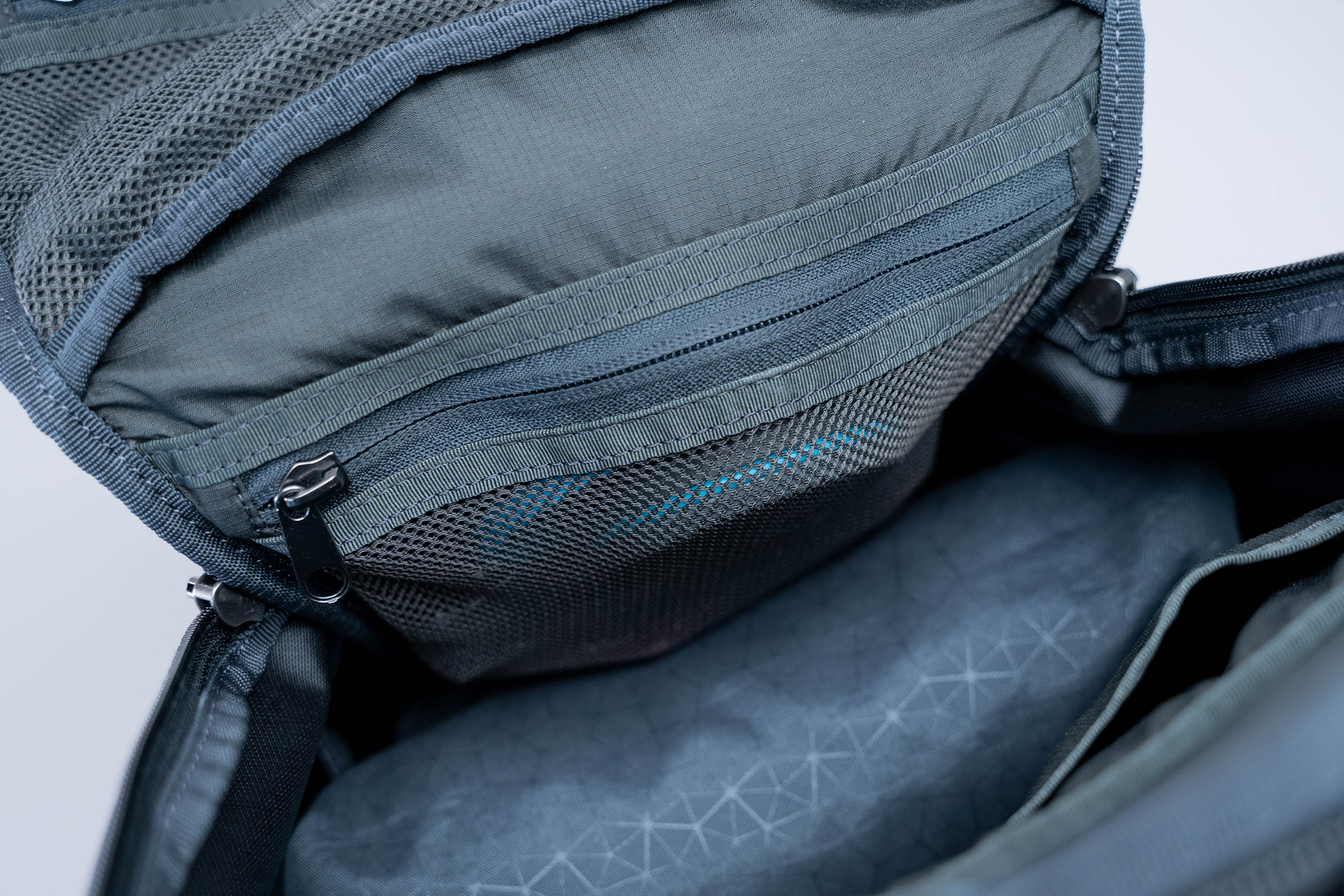
Loading up that second pocket—as we have space to do—also affects how easy it is to toss other items in the rest of the open space. We have nearly seven inches to slide things into the bag at the widest when completely undoing the main zipper. Fill that second pocket, however, and that reduces dramatically, leaving only about three inches of space to reach (and see into) the bottom of the bag.
That’s why we would like Thule to have extended the zipper down to the water bottle pockets: it would give the bag a better clamshell-type opening to make for easier packing of the available space. A lunch, a sweatshirt, and other items can fit; we just wish it wasn’t so hard to do so. As it is, we want you to be aware, so you can pack larger items before filling the pockets when possible. The space is there; we just have to use it creatively.

Opposite the pockets is the laptop compartment. As device containment goes, this is pretty straightforward. A 13-inch laptop slides into the padded sleeve along the back of the pack, and there’s a little added cushion at the bottom to protect it if it slips from our fingers. On the front of that sleeve is a second pocket that will fit another 10-inch device—whether you prefer a tablet, e-reader, wireless keyboard, or a Nintendo Switch (we know you need a break to catch up with your villagers in Animal Crossing).
All in all, the Thule EnRoute 14L is a great backpack for everyday use, and it switches gears seamlessly from office to adventure for more action-packed days.
Usage Timeline
Condition: Excellent
- Really appreciate the strap keepers
- Interested to see how U-shaped opening works in real life
- Elastic mesh side pockets seem like a good fit for a variety of bottles
Condition: Excellent
- Fabric easy to clean
- Back panel and straps very breathable
- Needs to be packed in a certain order to make use of entire capacity


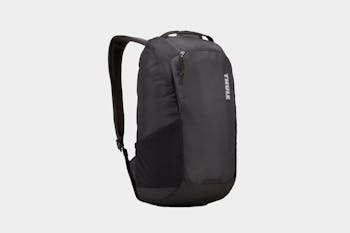






Get your questions about the Thule EnRoute Backpack 14L answered from our team and the Pro Community right here on the page. Plus, join discussions with other members about gear, guides, and more.
Join Pack Hacker Pro or, Sign In